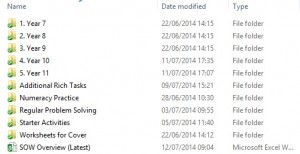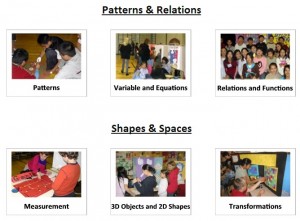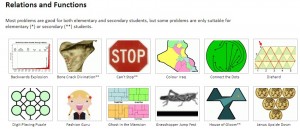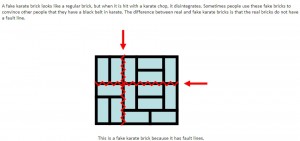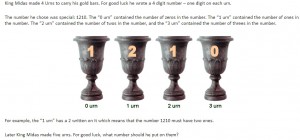You can view all the posts in the epic “Writing a Maths Scheme of Work” series on this page. It’s kind of like Game of Thrones, only with slightly less nudity and dragons.
As I talked about in my post about the structure of our new maths scheme of work, each Topic Unit will have one compulsory rich task that all students will do across the year group, alongside a selection of optional rich tasks and problems each related to the specific Topic Unit. I have talked about a few sources of these rich tasks in previous posts, and there will be more to come in future posts.
But today, something different…
As I have discussed, we are dedicating more lesson time than ever to covering topics. This is in an effort to ensure deep learning and understanding from our students, and to give teachers the flexibility to run with a given task or idea if their students are really responding to it. We are also insisting that everyone moves onto the next Topic Unit at the same time, to ensure consistency and make staff discussions and training sessions as useful as possible.
However, I am aware that some times all concerned have simply had enough with a given topic. This could be for a number of reasons. Perhaps a lower attaining group has covered as much of the topic as they are able to, and despite everyone’s best efforts they are not able to access the extra skills or concepts that other sets are working on. Conversely, perhaps a higher attaining group has finished all the material and are ready for another challenge.
What is to be done in these situations if staff are asked not to move onto the next Topic Unit?
Well, these is where the Additional Rich Tasks folder comes into play! 🙂
This folder will sit at the front of our scheme of learning:
I will talk about the other folders in future posts – I bet the “Worksheets for Cover” has caught your eye 🙂
The idea behind the Additional Rich Tasks folder is that if staff find themselves with a lesson or two to spare before everyone is moving on to the next Topic Unit, they can dip into this folder and select an appropriate task. Now, crucially these tasks might be on something completely unrelated to what the class has just been studying. They might not even cover a specific maths topic, and instead look to develop more general skills of investigation and problem solving.
This folder is for all year groups and ability levels.
There are a few sources of these rich tasks that I am using to populate this folder, but the one I wanted to mention today was from a website called Galileo, as it is a relatively new discovery for me, and I reckon it suits our scheme of work’s needs perfectly!
This is a US site, and as their About page explains: “Galileo Educational Network is an independent, charitable organization that consists of thought-leading educators and a high profile Board of Directors. ”
As well as lots of links, articles and research about fascinating topics such as inquiry based learning, question design and digital technology, it is the lovely Math Fair Problems that caught my eye!
The problems are broken down into broad topic areas:
Within each broad topic area there are a selection of problems.
The website explains that “Most problems are good for both elementary and secondary students, but some problems are only suitable for elementary or secondary students“, and these are indicated with *
Each problem has it’s own page, but is also available to download as a pdf. So, for freaks like me who like to have everything available offline, it is ideal.
What is even better are the problems themselves. These are not jut quick fire puzzles. These are rich, deep problems that will challenge students of all ages and abilities.
They usually start with an opening challenge or question to investigate, but then there is always Extension work suggested. The prompts and possible lines of inquiry suggested in the Extension are superb. And if that wasn’t enough, each problem also has a “The Math in this Problem” section at the end.
Let me pick out 3 of my favourite tasks to give you a flavour of the materials:
1. Karate Bricks
This is a lovely activity that challenges students to arrange a variety of shapes in a way so that there is no continuous line going across them. It starts with rectangles and then moves onto triangles. And in the Extension section, there is also the challenge of doing some proof:
- Prove that there is no real rectangular karate brick made of 5cm x 10cm dominos that is 20cm wide.
- Prove that there is no real square karate brick made of the same dominos that has a 30cm side.
- What is the smallest cube that can be constructed of smaller cubes so that there are no fault planes?
- Can you find other fake and real constructions like the pipes and bricks and email them to Galileo.
- How many ways are there to create a fake rectangular karate brick that is 15cm wide and
- 10cm long
- 20cm long
- 30cm long
- 40cm long
- 50cm long
- 60cm long
- Do you recognize a pattern?
What a lovely activity! 🙂
Click here to find the task
2. Snake in a Box
This is a lovely number arranging activity that really tests and develops students’ problem solving skills. It starts off nice and easy, with students playing against each other to hide a snake (you will need to read the task to find out what a snake involves, but suffice to say, it is not a real one). And then students are asked to investigate how other snakes could be hidden, which arrangements are possible, and which are not.
Here is a selection of the Extension questions:
- How many numbers in a 5×5 box is it possible to know and still not know how the snake is wrapped up?
- If a master snake charmer knows the position of the numbers 1, 4, 9, 16 and 25 can the master snake charmer determine how the snake is wrapped up? If not, is there another group of numbers that does this? How small can the group of numbers be?
Again, lovely stuff! 🙂
Click here to find the task
3. The Urns of King Midas
I have chosen this one as I only discovered it this morning when I was writing this post. It has hooked me straight in, and my plan is to have a play around with it whilst my fiancée is catching up with Made in Chelsea this evening 🙂
Click here to find the task
So, there you go!
I hope these tasks will both engage and challenge our students. I absolutely love them, but then I am a massive geek.
More so with problems like this than with “traditional” lessons, it will be absolutely crucial that staff try out these tasks themselves before the lesson to anticipate the kind of questions their students might ask, and have prompts lined up for when they are stuck. Whilst I am all in favour of being surprised myself in lessons, I think teachers need a certain familiarity with the rich tasks before using them with students.
In my weekly training sessions with our department, I am going to pick out one of these tasks and have a look at it with staff, all of us doing the activity together, and then having a chat about how we found it and how we might run it with our classes. I think I might also ask staff to lead these mini sessions on a rota basis, each time picking out one of the Math Fair problems that has caught their eye. This again feeds into my desire to make everyone feel part of this new scheme of learning.
